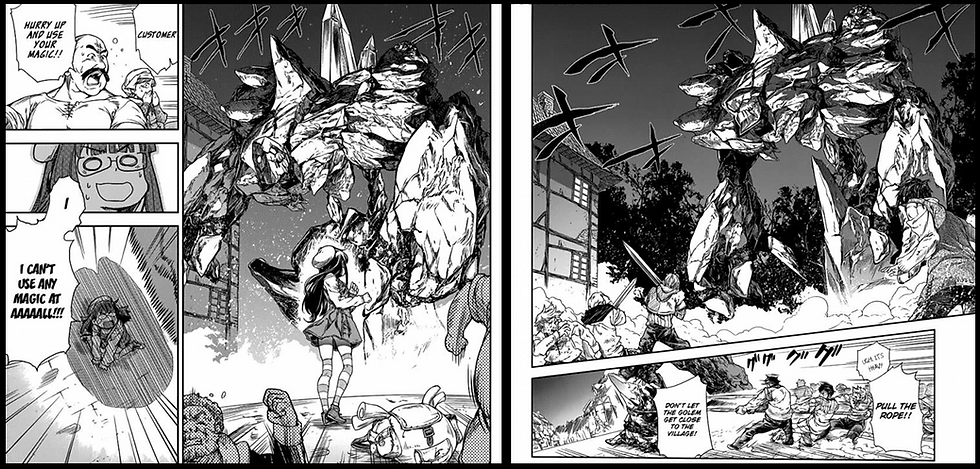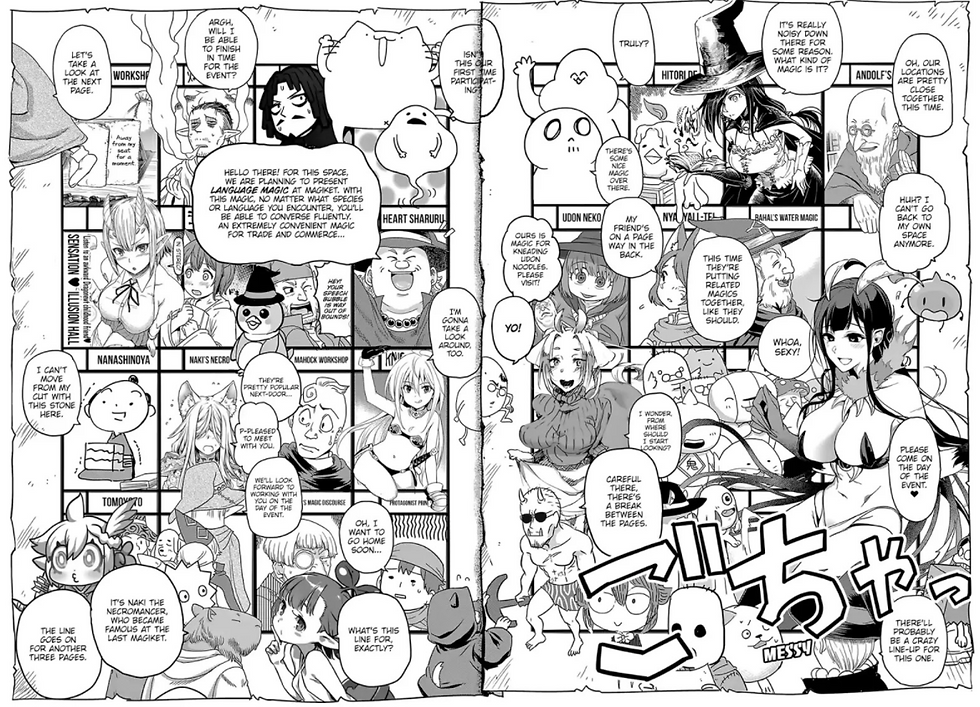Shelf Life: A Witch's Printing Office (Vol. 1)
- Joseph Lutholtz
- Sep 26, 2020
- 6 min read

Alternative Names: Mahoutsukai no Insatsujo
Scores: 6/10, 4/5
Genre: Isekai, Fantasy, Comedy, Job Shadow, Magic
Publisher: Kadokawa and Yen Press
Isekai stories are, let's be honest, something of an over-saturated genre in the world of anime and literature. Comparable to the penny dreadfuls of the 19th century and the food-themed murder books that line the shelves of bookstores and libraries today, the "...In Another World" genre has seen such a boom that it isn't much of an exaggeration to claim that only 1-in-10 isekai stories get adapted into an anime each year. Regardless of what the actual number of published isekai stories might be, though, the fact of the matter is that the genre has become a paint-by-numbers formula. We've all seen the song and dance done so many times that we can literally tell what the book is about by its cover--thanks in no small part to the naming conventions of light novels. More than that, though, it almost feels like we've moved past the point of gimmick hunting to keep the genre interesting. Everything feels like it's been done already and there's honestly nothing new the genre can offer, assuming you've followed the genre since its grand debut in the early 2010s. Yet, funnily enough, I've found that this degree of over-saturation and gimmick hunting has reinvigorated my appreciation for the tropes found in classic isekai. For a perfect example of what I mean by that, look no further than Mochinchi (author) and Miyama Yasuhiro's (illustrator) debut manga, The Witch's Printing Office.

The old is new and the new is old. Long live Isekai!
From the ground up, The Witch's Printing Office seems to run off of the belief that simplest is best. From its premise to its characters and its light, almost slice of life-like story beats, everything about this story tries to keep things as simple as possible. For example, our main protagonist Mika isn't brought to the story's fantastic world by anything so convoluted as reincarnation, summoning, or even a magic portal. Rather, she just kind of appears within the magical setting without any fanfare or explanation. One minute she's leaving Comiket with a backpack full of swag and in the next she finds herself trapped in a fantasy world full of magic and monsters.

Don't panic; the monsters are mostly harmless.
Unlike other isekai protagonists, though, Mika doesn't see her instant transmission to another world as a dream come true, a blessing in disguise, or a new lease on life. Rather, she finds it really annoying and instantly starts looking for a way to get back home. While this difference in character motivation is meant to be a comedic switch-up from the standard isekai formula, her desires and the unceremonious lean to her transportation actually feels more in line with classic isekai than her modern counterparts. I am referring to the age when the isekai genre was just starting out and the tropes hadn't been fully established yet. Specifically, shoujo isekai like Kanata kara (From Far Away), Inuyasha, Magic Knight Rayearth, and Fushigi Yugi all come to mind when I try to compare this story to others I've watched and read over the years. Perhaps I'm only drawing those connections because these series all feature a female protagonist who wants to return home or maybe it's because Mika is, like many classic female protagonists, is more of a vehicle for a larger fantasy story than a character in her own right.

Yup, even classic isekai were filled with sock puppet MCs, brain-dead damsels in distress,
and all the other generally sexist practices we know and love today.
Just to be clear, though, it's not like The Witch's Printing Office is totally divorced from the tropes and practices of its contemporaries. Much like Reincarnated as a Smile and Ascendance of a Bookworm, Mika's arrival in this fantasy world sets off a magical renaissance that's modeled after the things she loved back in Japan and quietly pushes her personal agenda onto the world at large. Namely, as a means to bolster her search for a magical tome or spell that could send her back home, Mika somehow--the book never goes into detail how she accomplished this--manages to assemble a variety of magical researchers and independent mages to create this world's first-ever "magic market" or Magiket, for short.

*groan*
Terrible as that pun might be, the series actually manages to do quite a bit with its main plot point of regularly running a magical Comiket and manages to translate the concept well to a fantasy setting. From using an order of holy knights as the security forces to wizards trying to get away with selling spells that are dangerous and shouldn't be available to the general public, the basic premise lends itself to lots of situational comedy that'll speak to anyone familiar with otaku and convention culture.

Including those filthy doujin sellers.
For anyone unfamiliar with the barrage of references and activity found in the Magiket-focused chapters, the series' other setting might prove to be more up their alley. Balancing out the non-stop hijinks of the magical trade fair, every other chapter trends toward a more slice of life vibe as it follows the daily life of Mika and her team of assistants as they run a magical printing office. While still connected with her role in managing Magiket, these chapters help ground and establish both the nature of this fantasy world and Mika's place in it. Namely, like many isekai protagonists before her, Mika's knowledge of self-publishing and her newfound copy & paste magic gives her the ability to revolutionize the magic tome and scroll industry of this world, opening up a variety of opportunities for its native people. From helping blacksmiths develop "replica" weapons that can be safely brought to Magiket to mass production of powerful spells and summons, her efforts steadily push this world closer to the otaku culture she loves and also improves the lives of people regularly attacked by monsters and bandits.

Albeit at the cost of her and her employees' sanity.
In other words, The Witch's Printing Office steadily proves itself to be your basic, wish-fulfillment isekai built to play off the comedy of otaku culture in a fantasy world that is in and of itself a running list of references to popular fantasy games and anime. Accurate as that summary might be, though, I won't deny that the series got me invested in its world, characters, and its brand of comedy. As ill-defined and nonsensical as Mika's place is in this world, the overt silliness and lack of seriousness make it all a lot easier to swallow. In the same breath, however, I'll be the first to say that this series is anything but perfect.

Yeah, it's a bit of a mess.
From the conceptual level to its general execution, The Witch's Printing Office suffers from several different problems that make it a difficult work to really get into. For example, like most isekai stories that feature a protagonist sparking a cultural renaissance, the rise of Mika's otaku wizarding world is only made possible by turning every native inhabitant of this world into idiots incapable of thinking past their own nose. Her use of copy magic to mass-produce a spell, for one, makes little to no sense in a world where that kind of availability is key to the survival of a town. For another, her being the first to create a magical trade convention doesn't make too much sense since this world already seems to have schools and workgroups that develop magic in the same way that some publishers only deal in a particular genre. The most galling example of this, though, is the moment she somehow ends up being a "genius" for thinking to combine two different spells to resuscitate a deceased con-goer.

Conceptually idiotic as the skit might have been, I won't lie that it pulled on my heartstrings a little.
Moving past my general issues with this trope, another easy complaint that could be leveled against this series is that it's far too visually busy. Particularly during the Magiket chapters, a single panel will feature a dozen or so characters, key background details, and a few good speech bubbles for good measure. At first, this attention to detail and work to visually build the world in our minds feels distinct and charming. But, eventually, all that visual clutter starts to become a chore. Trying to find the visual gag in a literal crowd of mob characters takes away from the humor and makes it harder to appreciate what is otherwise some pretty fantastic work.

Can you spot the Dragon Quest and Final Fantasy references in this two-page panel? I did
once someone mentioned that they were there but I'd rather just appreciate the big picture.
When all is said and done, I have to say that I still really liked reading The Witch's Printing Office. Maybe that's just because I was lucky enough to be the right kind of reader for it--aware enough to catch most of the references and gags it was going for. I'd like to think, though, that the story had enough going for it to make it a generally fun ride. Mika might be quietly looking for her way to get home but the differences and connections she makes while in this world make it a nice, easy, and mostly wholesome laugh.


Comments